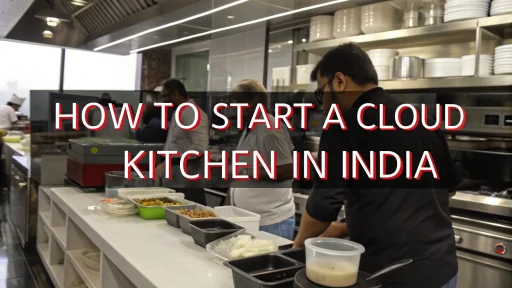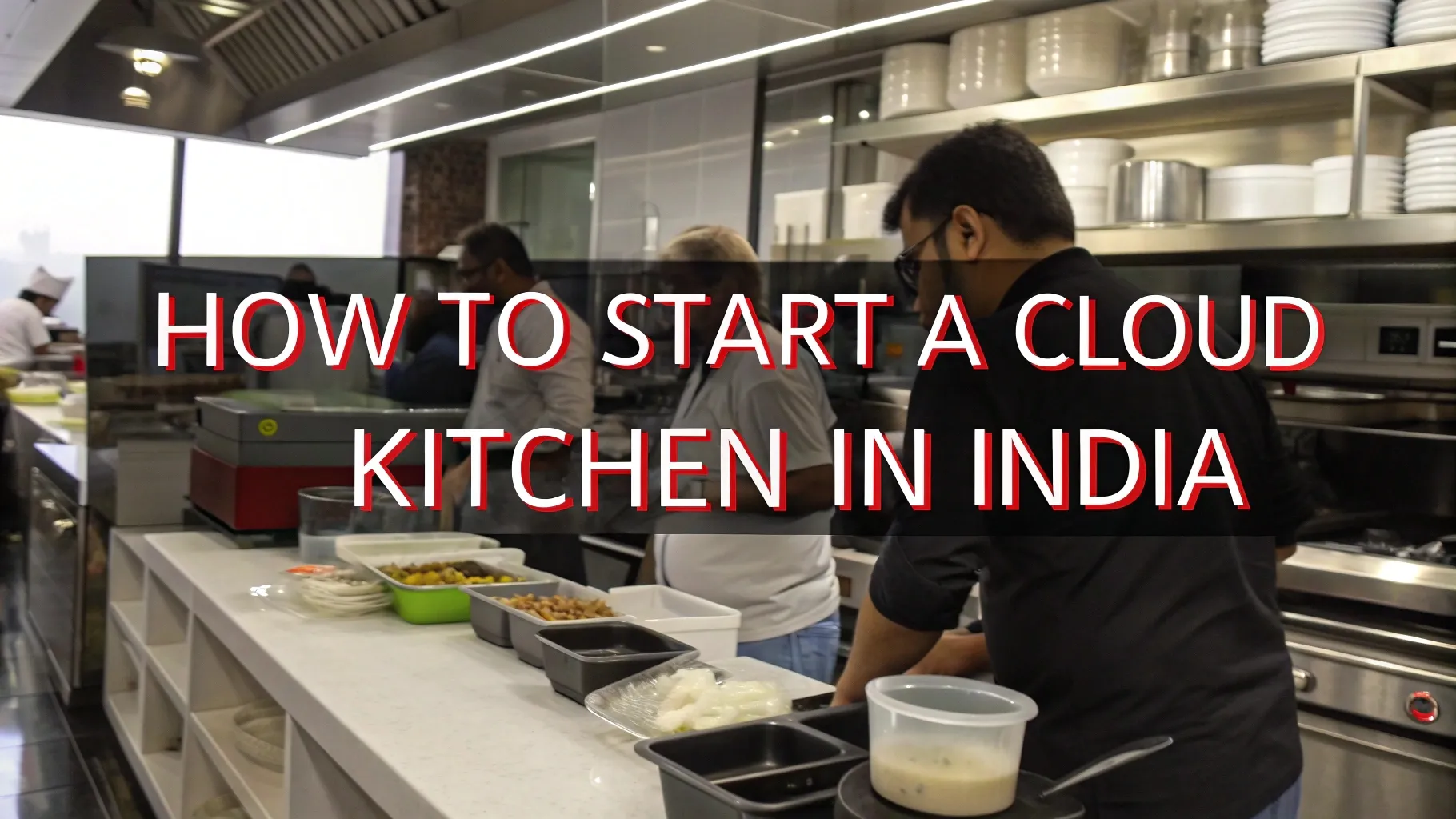Recently, cloud kitchens have emerged as a powerful disruptor in India’s food and beverage industry. The modern consumer’s digital-first ordering approach, along with growing urban populations, is rendering traditional dine-in restaurants obsolete. The nucleus of this transformation is the cloud kitchen, also referred to as ghost kitchens or virtual restaurants.
For technicians, new entrepreneurs, and business strategists seeking easily scalable solutions, the cloud kitchen industry presents an enticing opportunity. Success in this domain requires more than just setting up a stove, creating a Zomato account, and starting to serve. You need a deep understanding of Zomato’s menu licensing framework, operational workflows, and the broader business‑licensing ecosystem. Rigorous compliance oversight and long‑term forecasting are also essential for sustainable growth and SEO visibility.
This guide offers all the necessary information starting from operational zoning plans to sweeping future demand forecasts for cloud kitchens in India. This includes everything from legal descriptions, working blueprints, industry analytics, and long-term projections.
The Cloud Kitchen Industry: India’s Growing Need for Convenience
The last five years have seen a massive increase in demand for online food delivery in India, and the trend shows no sign of slowing down. The rise in working professionals is driving the need for cost-effective services, and cloud kitchens are emerging to meet the requirements, unlike dine-in restaurants which are costly. The market is also being driven by India’s digitally inclined Gen Z and millennial population who want more variety and affordable options that can be accessed through apps.
Unlike traditional restaurants and eateries, cloud kitchens do not need a specific footfall or a prime location. Their model is quite the opposite; they work out of rented kitchens located in less expensive areas, and only serve customers through aggregator platforms like Zomato and Swiggy. This model eliminates many operational challenges, such as controlling costs, increasing speed to market, and scaling up which makes it a very attractive option for foodpreneurs and startup founders.
India’s Cloud Kitchen Market Forecast (2025–2030)
| Year | Estimated Market Size (INR Cr) | Annual Growth Rate | Key Growth Factors |
| 2025 | ₹7,300 Cr | 17% | Digital delivery platforms, affordable setups |
| 2026 | ₹8,540 Cr | 17% | Hyperlocal expansion, Tier-II market entry |
| 2027 | ₹10,000 Cr | 17% | Menu personalization, health-focused brands |
| 2028 | ₹11,700 Cr | 17% | Franchising, tech-backed operations |
| 2029 | ₹13,600 Cr | 16% | Bulk meal prep, cloud catering |
| 2030 | ₹15,500 Cr | 14% | Smart kitchens, robotics, cold-chain logistics |
The forecast indicates tremendous growth potential—and also new models of operation. By 2030, I predict even more fragmentation in the industry, with services ranging from basic tiffin deliveries to high-end ethnic cuisine and vegan offerings.
Related: Top 7 Cloud Kitchen Models: Which One Suits Your Business?
Understanding the Cloud Kitchen Model
In essence, a cloud kitchen is a type of restaurant that has no dine-in facility and therefore operates as a delivery-only establishment. Orders come through various food delivery apps, or their websites and apps and are directly sent out to the customer. Since there is no face-to-face interaction with consumers, no ambiance, table service or in-house dining-related overheads, everything is streamlined.
This model brings many strategic opportunities. With lower real estate costs, entrepreneurs can invest their capital in kitchen technology, food quality, and training staff. In addition, businesses are able to separate the kitchen from the dining experience. This enables them to change menus as they see fit, create multiple virtual brands from the same kitchen, and fine-tune the supply chains with laser-focused accuracy.
For industrial consultants and planners in the food industry, it is vital to note that a cloud kitchen is not a single format. Rather, it is a spectrum. From one independent branded solo units to multi-branded shared units, aggregator-hosted kitchens and everything in between, the model has immense flexibility. Depending on the vision, one can start with compact 300 sq. foot units or scale right up to 10,000 sq. foot commissary units servicing multiple cities.
Cloud Kitchen Legalities and Licenses in India
A cloud kitchen’s legal groundwork is often misunderstood. Without a dine-in area, many entrepreneurs assume that licenses and permits will be simpler to acquire. On the contrary, all-purpose kitchens are governed by a stringent umbrella of compliance for the safety of food, labor standards, and taxation regulations.
- An FSSAI (Food Safety and Standards Authority of India) license is the first requirement. This license indicates that the food production is up to hygiene, safety, and labeling standards. Depending on your operation scale—be it locally delivering meals prepared from home to multi-brand operations—the classification for the license would be Basic, State, or Central.
- It’s crucial to register your business under the Shops and Establishment Act. This registration legitimizes your business, which is necessary for applying for other additional licenses or opening a business bank account.
- A Trade License from the local municipal authority is also needed, permitting to run a food business in defined commercial zones.
- If your kitchen utilizes gas or goes beyond a certain size, then a Fire Department NOC (No Objection Certificate) is required. This line of work has strict inspections for fire safety, which is particularly important in food service businesses.
- Urban area kitchens, particularly residential center zones, will need to get approval from the Pollution Control Board. Cloud kitchens that use exhausts, discharge wastewater, or store food waste may fall under the “Orange” classification and will require a Consent to Operate (CTO) certificate.
- A GST registration becomes mandatory when your annual revenue crosses ₹20 lakhs (or ₹10 lakhs in certain states).
- For kitchens with more than 10 employees, it is mandatory to register under ESI and PF laws.
These licenses are crucial not just for aggregator listings and third-party logistics partnerships but also for acquiring funding for the business.
Cloud Kitchen Manufacturing Process: A Functional Overview
From a consumer’s point of view, the cloud kitchen model may appear simple, but the operations at the backend are akin to a miniature manufacturing plant. Each segment, right from ingredient sourcing to last-mile delivery, requires meticulous designing, workflow mapping, and SOPs.
Raw Material Sourcing & Inventory
As with any process, the last step starts with raw materials sourcing. In terms of perishables, kitchens and other food manufacturers depend on bulk suppliers, mandi vendors, organized B2B marketplaces, and farm to fork suppliers for regular delivery of fresh produce, grains, dairy, and meat. Inventory systems must embrace perishables with FIFO (First In, First Out) and cold storage must be HACCP compliant to prevent spoilage.
Food Preparation & Safety Compliance
Next is the food preparation step, which is divided into mise en place, or pre-prep, and the actual cooking. Recipes are standardized, including measuring, cooking times, and temperatures to make execution uniform across the board. Staff training at this stage is vital, particularly at multi-brand kitchens where different cuisines require varied workflows.
Cooking areas within a kitchen are organized into sections due to the nature of the food being prepared. For instance, vegetarian and non-vegetarian meals should be prepared in distinct areas. To ensure safety, there are raw and cooked categories within meals. Furthermore, kitchens have to comply with safety regulations, which is why they install chimneys, oil filters, and ventilation systems.
Packaging & Delivery Integration
As food moves through different stages, it is critical to pay attention to packaging as well. Food items need to preserve their freshness, temperature, and even texture while being transported. Preserving brand reputation and reducing customer complaints can be achieved through high-quality, spill-proof, and tamper-proof packaging.
These can further be dispatched via third-party companies, for example, Swiggy or Zomato, or using in-house delivery fleets. These systems need to be integrated with the POS systems, enabling real-time tracking of order status, alerts for delays, and automated customer feedback loops.
With only a click away, ordering food appears to be effortless. However, in the background, there is a real-time managed, tech-supported mini-factory that fulfills each order.
Related: Manufacturing Business Opportunities in Indian Kitchen Spices
India’s Urban Dining Shift and the Rise of Cloud Kitchens
India’s urban dining lifestyle is experiencing a drastic change. The enjoyment of going out for a meal has been replaced in many instances by the ease of having a warm meal delivered to one’s doorstep in under thirty minutes. From an entrepreneurial standpoint, this shift creates an explosive opportunity.
Hyper-Automation and the Future of Cloud Commissaries
Further, we are witnessing the emergence of hyper-automated cloud commisaries that focus on order volume forecasting with the aid of AI technologies, robotic pre-prep task assistants, and cold-chain logistics enabling expanded delivery ranges. Data-driven engineering menus—where cuisine construction optimization occurs based on customer orders, feedback, and profit margins—is gaining traction.
Other than B2C sales, cloud kitchens are expanding into the B2B sphere with catering contracts, office pantry services, and food supply chains for institutional kitchens. The logic is straightforward: good food prepared in an efficient manner can serve multiple channels.
With the improved infrastructural delivery frameworks for tier two and tier three cities, we should anticipate a new wave of cloud cuisine growth based on local ingredients, regional cuisines, and affordability.
How NPCS Assists Food Business Entrepreneurs and Kitchen Startups
For first-time food entrepreneurs, starting a cloud kitchen is a significant investment. That is where NIIR Project Consultancy Services (NPCS) comes in. NPCS has considerable experience in business planning and industrial feasibility, and they aid in a variety of new venture services to assist entrepreneurs in confidently launching their businesses.
NPCS prepares Comprehensive Market Survey cum Detailed Techno Economic Feasibility Reports for cloud kitchen and other food manufacturing startups. These reports provide detailed market analysis and include in-depth insights on the entire manufacturing process, raw materials, plant layout, regulatory pathways, and comprehensive financial modeling.
For entrepreneurs and startups who are lost on where to start from or how to scale up responsibly, NPCS provides risk assessment, strategy, and vision-guided roadmaps alongside providing responsibility clarity.
Final Thoughts: From the Cloud Building India’s Next Great Food Brand
The cloud kitchen is now a widely accepted, scalable business model that complements India’s increasing urban ecosystem. As with any other business, success in this model doesn’t come effortlessly. It requires in-depth planning, stringent compliance, process optimization, and a constant focus on quality food.
Given the increasing customer traffic, technology, and access to services, cloud kitchens present one of the most promising and interesting opportunities for new business owners and small-scale manufacturers. However, while beginning at a small scale may be tempting, it is best to adopt an industrial mindset from the very first day.
Make sure to establish your processes with scaling in mind. Establish the legal groundwork early on. Record your recipes as operational schematics. And above all else, ensure your order fulfillment process gives the impression that this is an introductory order, because in cloud kitchens, it usually is.







